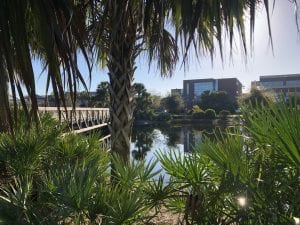UCF Stormwater

Central Florida is known for its summer thunderstorms that sometimes dump large amounts of rain in short bursts. People are used to seeing water flowing along gutters and rushing into roadway drains, but not everyone understands the hidden infrastructure for stormwater runoff and how it is designed to protect our precious water resources.
Stormwater runoff is rain or snowmelt that flows over land or impervious surfaces (such as paved streets, parking lots, and building rooftops) and does not soak into the ground. Improperly managed stormwater runoff can cause flooding, alter the natural hydrology, or degrade water quality by carrying pollutants into our rivers, lakes, and streams. To reduce runoff impacts, stormwater is federally regulated, but each municipality, including UCF, has a unique permit management plan that works best for them.
UCF’s stormwater does not go through a water treatment facility. Signs that read “no dumping, drains to lake” are installed on curb inlets across campus to remind people that our stormwater runoff ends up flowing into local lakes and streams. The stormwater flows through underground infrastructure directly into constructed stormwater ponds, designed to capture large amounts of water and let it slowly release over several days through outflow structures. Pollutants and sediment settle out as the water moves through the pond. Stormwater from campus flows directly into the Little Econlockhatchee River, so the actions taken on campus affect aquatic plants and animals, and water quality for miles downstream.
In an effort to reduce the amount of trash in our stormwater ponds and in the natural system, UCF has implemented an adoption program where student organizations can adopt a pond or road and volunteer to collect trash once a month. Roughly 16,000 gallons of trash and recyclables are collected annually. Additionally, there are baffle boxes installed at pond outfalls that receive heavy amounts of debris. These structures filter trash out of the water before it reaches the pond and are cleaned out annually. Last year alone, 2 full dump trucks of debris were removed from our baffle boxes.
The number 1 pollutant of stormwater is sediment, which clouds water and alters hydrology when deposited in large amounts. Construction sites are often the main culprit when it comes to sediment deposits. UCF monitors construction sites on campus closely, enforcing rules put in place by the Florida Department of Environmental Protection that outline what steps need to be taken in order to keep sediment on site and out of the stormwater.
Nutrient runoff is another major source of water pollution because excess nutrients can contribute to harmful algal blooms—a major problem in Florida. The UCF landscape department follows nutrient best management practices (BMPs) for fertilizer to minimize nutrient runoff from campus. Everyone can do their part to help protect stormwater by being aware not to allow yard waste, trash or pollutants to enter storm drains, and properly dispose of hazardous materials.
